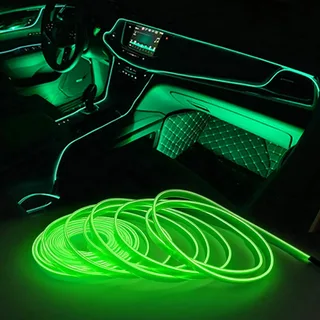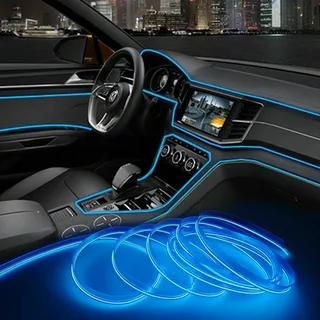In today’s automotive world, customisation and personalisation have become key aspects of vehicle ownership. One of the simplest yet impactful ways to enhance the interior aesthetics of your car is through car interior wire lights. These flexible, vibrant lights can transform the atmosphere within your vehicle, making every ride a unique experience. Whether you want to create a calming ambience or a dynamic light show, car wire lights offer a world of possibilities. With a wide array of colours and modes, you can tailor the lighting to suit your mood or the occasion.
Understanding Car Wire Lights
Car wire lights are essential components of a vehicle’s electrical system, playing a critical role in safety and functionality. Understanding how these lights work can help you diagnose issues and maintain your car more effectively.
Types of Car Wire Lights
A car has several types of wire lights, including headlights, taillights, brake lights, turn signals, and interior lights. Each serves a specific purpose and is connected through a network of wires that ensure proper functionality. Headlights illuminate the road ahead, while taillights and brake lights signal your presence to other drivers.
Wiring Basics
The wiring for car lights typically consists of positive (live) and negative (ground) wires. The positive wire carries electrical current from the battery to the light, while the negative wire completes the circuit. In most vehicles, these wires are color-coded for easy identification. Standard colour codes include red for positive and black for negative, although this can vary by manufacturer.
Troubleshooting Wire Lights
If a wire light malfunctions, it’s crucial to troubleshoot the issue promptly. Start by checking the bulbs; a burnt-out bulb is often the culprit. If the bulbs are intact, inspect the wiring for any signs of damage, such as fraying or corrosion. Use a multimeter to test for continuity in the wires. If you identify a break, you may need to splice in a new wire section or replace the entire harness.
Choosing the Right Wire Lights for Your Car
Wire lights can be a fantastic addition to enhancing your vehicle’s aesthetic appeal and safety. However, selecting the correct wire lights requires careful consideration of several factors to ensure compatibility and functionality.
First and foremost, consider the type of wire lights you want to install. Options range from LED strips to traditional bulb-based lights. LED lights are famous for their energy efficiency, longevity, and low heat emission. They come in various colours and can be easily customised to fit your vehicle’s design. On the other hand, traditional bulbs may offer a classic look but consume more energy and have a shorter lifespan.
Next, think about the purpose of the wire lights. Are you looking to add ambient lighting inside your car or consider exterior lighting for visibility and safety? Interior lights can create a cozy atmosphere and highlight the dashboard. In contrast, exterior lights can improve nighttime visibility and signal your presence on the road. Choosing lights that serve your intended purpose is essential without violating any local regulations regarding vehicle lighting.
Installation is another crucial factor to consider. Some wire lights come with adhesive backing, making them easy to install, while others may require professional installation or basic wiring knowledge. Assess your comfort level with DIY projects before making a purchase. Additionally, ensure that the lights you choose come with adequate instructions and mounting hardware.
Lastly, pay attention to the quality and durability of the wire lights. Opt for water-resistant products made from high-quality materials to withstand harsh weather conditions. Reading reviews and checking for warranties can help you make a more informed decision.
Installation Guide for Car Wire Lights
Installing car wire lights can enhance your vehicle’s appearance and increase visibility at night. Proper installation is key for both safety and aesthetics, whether you’re adding LED strips, underbody lights, or interior lighting. Here’s a step-by-step guide to help you install car wire lights effectively.
Step 1: Gather Your Materials
Before you begin, ensure you have all the necessary materials. You will need the wire lights, a wiring harness (if not included), electrical tape, heat shrink tubing, wire connectors, and basic tools like a screwdriver, wire stripper, and multimeter. Always choose lights compatible with your vehicle’s electrical system to avoid complications.
Step 2: Plan the Layout
Determine where you want to place the lights. Common locations include the interior, under the dashboard, along the footwells, or on the vehicle’s exterior. Make a rough plan of the wire routing, ensuring that the lights are evenly spaced and won’t interfere with any moving parts.
Step 3: Prepare the Surface
Clean the surfaces where you plan to attach the lights. Use a degreaser to remove dirt and oils to ensure proper adhesion. A clean surface will help the adhesive bond better for lights that require adhesive backing.
Step 4: Install the Lights
Carefully peel off the adhesive backing (if applicable) and press the lights firmly into place. For external lights, you may need to use screws or brackets for added stability. Be sure to follow the manufacturer’s instructions regarding the installation method.
Step 5: Connect the Wiring
Connect the wire lights to the vehicle’s power source. It’s crucial to identify the positive and negative wires correctly. Use wire connectors to join the cables, and secure all connections with electrical tape or heat shrink tubing. If you’re unsure, consult a wiring diagram specific to your vehicle.
Step 6: Test the Lights
Once everything is connected, please turn on your vehicle and test the lights to ensure they function correctly. Check for any flickering or non-responsive sections and troubleshoot as necessary.
Maintenance Tips for the Wire Lights
Wire lights, often used for decoration during festive seasons or special occasions, require attention to ensure they remain in good working condition. Here are some essential maintenance tips to keep your wire lights shining brightly.
1. Regular Inspection
Periodically inspect your wire lights for any signs of wear or damage. Look for frayed wires, broken bulbs, or any corrosion affecting functionality. Addressing these issues early can prevent more significant problems later.
2. Cleaning
Dust and dirt can accumulate on wire lights, dulling their brightness. Use a soft, dry cloth to wipe down the wires and bulbs gently. You can lightly dampen the cloth with water or a mild soap solution if necessary. Ensure the lights are unplugged while cleaning.
3. Proper Storage
Store your wire lights properly when not in use to avoid tangling or damage. Coiling them carefully and placing them in a protective container will help maintain their shape and functionality. Avoid storing them in damp areas, as moisture can cause electrical issues.
4. Use of Designated Surfaces
Ensure wire lights are used on safe and suitable surfaces for their design. Avoid placing them in areas with excessive heat or moisture. This practice not only enhances safety but also prolongs the lights’ lifespan.
5. Replace Faulty Components
If one bulb goes out, it can affect the entire string of lights. Replace faulty bulbs as soon as possible to maintain the full brightness of your wire lights. Always use compatible replacement bulbs recommended by the manufacturer.
Troubleshooting Tips for the Wire Lights
Wirelights can add a beautiful ambience to any space, but they can also encounter issues that may prevent them from functioning correctly. Here are some troubleshooting tips to help you resolve common wire-light problems.
Check the Power Source
First and foremost, ensure that your wire lights are correctly connected to a power source. Check the outlet by plugging in another device to see if it functions. If you are using an extension cord, inspect it for damage or loose connections. Additionally, verify that any switches or timers associated with the lights are turned on.
Inspect for Damage
Next, visually inspect the entire length of the wire lights for any signs of damage. Look for frayed wires, broken bulbs, or loose connections. If you find any damaged sections, they may need to be repaired or replaced to restore functionality.
Test Individual Bulbs
Test each bulb individually if only a portion of your wire lights is not working. Most wire lights allow you to remove bulbs easily. Replace any burnt-out bulbs with new ones, ensuring they match your light string’s voltage and wattage requirements.
Examine the Connections
Finally, all connections along the wire lights should be examined. Ensure that all plugs are securely connected and that no corrosion is present on metal contacts. Clean any corrosion with a mild solution, and reconnect all plugs firmly.
Following these troubleshooting tips, you can effectively diagnose and fix issues with your wire lights, ensuring they shine bright in your space.
Benefits of Using Car Wire Lights
Car wire lights, often called LED strips or car accent lights, have gained immense popularity among automotive enthusiasts and everyday drivers. These lights offer a variety of benefits that enhance both the aesthetics and functionality of vehicles.
One of the primary advantages of car wire lights is their ability to enhance the visual appeal of a vehicle. With various colours and patterns, drivers can customise their car’s interior and exterior to match their style. Whether it’s for a vibrant party atmosphere or a subtle glow to create an elegant ambience, these lights can transform the look of a car, making it stand out on the road. Additionally, some wire lights come with features like colour-changing options and remote controls, allowing users to create dynamic lighting effects that can be easily adjusted.
Car wire lights can serve a practical purpose in terms of safety. Installing LED lights under the car or in the wheel wells can improve visibility during nighttime, making the vehicle more noticeable to other drivers. This can be especially beneficial in low-light conditions or during inclement weather. Moreover, wire lights can be strategically placed to illuminate critical areas of the car, such as the engine bay or trunk, assisting with maintenance tasks after dark.
Furthermore, car wire lights are typically energy-efficient and long-lasting. Most models utilise LED technology, which consumes less power than traditional bulbs while providing brighter illumination. This reduces the strain on the vehicle’s electrical system and minimises the need for frequent replacements, making it a cost-effective lighting solution.
Conclusion
Car interior wire lights present an exciting way to personalise your vehicle’s interior, adding aesthetic appeal and practical benefits. They enhance the ambience inside your car, whether you’re aiming for a calming glow or a vibrant, dynamic environment. These lights are user-friendly and energy-efficient, with easy installation and minimal power consumption. Regular maintenance ensures longevity and consistent performance, allowing you to enjoy a stylish, well-lit interior for years. With a wide range of colours and styles available, you can easily find the perfect match for your vehicle, making it uniquely yours.
FAQS
Q: Are car interior wire lights safe to use?
A: Yes, car interior wire lights are generally safe if installed correctly and meet relevant safety standards. Ensure all connections are secure and the lights do not interfere with your car’s electrical systems.
Q: Can I install car wire lights myself, or should I hire a professional?
A: Many car wire lights are designed for DIY installation, and detailed instructions are included. However, if you’re not confident in installing them, hiring a professional to ensure a safe and proper setup may be best.
Q: Do car wire lights drain the car battery quickly?
A: Car wire lights are typically energy-efficient and should not significantly drain your car battery. To conserve battery life, it’s important to turn them off when the car is not in use.
| Cme Blog Spot |
| Garcias Blogs |
| Yyc Blogs |
| Guiade Blogs |
| Blogs-Hunt |
| Impact-Blog |
| Smarty Blogs |
| Ed Blog |
| Mo Blogs |
| Blogs Em |
| Blog St |
| Related Business Listings |
| Contact Directory |
| Local Business Profiles |

